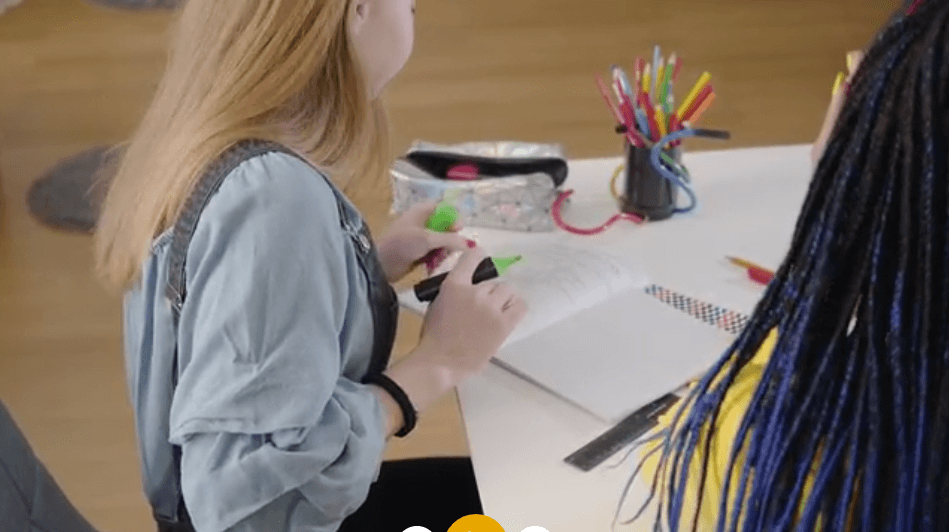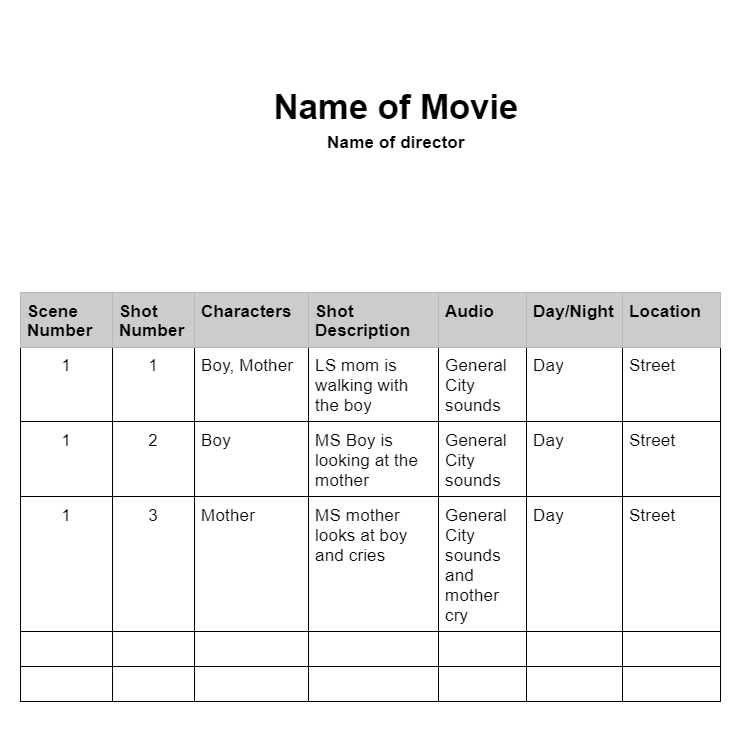Online Film School Free » Film Directing Course » Film Cinematography for Directors » Writing a Shooting Script
The Shooting Script - What is it and how to use it right?
Table of Contents
ToggleEvery great film starts with a vision. The thing is that translating the vision into a visual elements can be challenging and it will take more than just a creative mind. Let’s go together over the process of writing an effective shooting script, from understanding its structure to incorporating visual language that speaks directly to your crew.
What is a shooting script?
A shooting script is the filmmaker’s blueprint, the essential roadmap that guides directors, cinematographers, and actors through the production process. Unlike a traditional screenplay, it breaks down the story into shot-by-shot detail, ensuring that every angle, movement, and cue is accounted for.
The shooting script is a critical component in filmmaking, and writing it is a an important step in the journey from concept to screen. The shooting script is the filmmaker’s way of communicating with the other production departments about how the film will look. It is kind of another draft of the script written by the director or the cinematographer (depends on the production).
Using a shooting script before shooting will save time and money, and if your shooting script is detailed enough, there will be fewer chances of making mistakes that may crash your film. Usually, it is the director and the cinematographer who write the shooting script.

The difference between a shooting script and a screenplay
The screenplay’s purpose is to tell the story. The shooting script is about how to tell the story while considering the production needs. This is why the order of the scenes in the shooting script won’t follow the story’s chronological order. In most cases, the order of the scenes will follow the locations. If we have to shoot a few scenes in the same park, we will shoot them all on the same day, even if it’s not the chronologic order of the story.
Shooting script template and examples
There are many shooting script templates and shooting script examples on the internet. But basically, the shooting script is a table with details about the shots. Here’s a guide to the formatting of a shooting script:
- Scene Numbers – Each scene in the shooting script is numbered. These numbers are crucial for planning the shooting schedule and keeping track of the scenes during production.
- number of the shot
- Slug Lines – Each scene starts with a slug line, which indicates whether the scene is interior (INT.) or exterior (EXT.), the location, and the time of day.
- The explanation of what is happening in the scene should be written in the present tense and include details about the characters, their actions, and the setting.
- time of day
- Camera Directions – These are specific instructions for the camera, such as what type of shot to use (e.g., CLOSE UP, WIDE SHOT) or how to move the camera (e.g., PAN, TILT).
- The particular camera needed (like Steadicam)
- the location of the scene
If there are camera movements, write them down too. It would help if you wrote the dialogues in each shot and special sound effects critical to the scene. Write the lines of the characters. Each character’s name is centered above their dialogue, and parentheticals can be used to indicate how the lines should be delivered.
If the scene’s rhythm is essential (like in most action scenes, for example), write down each shot’s timing. The shooting and movie scripts need to be aligned all the time – especially the scene numbers.
I also recommend writing notes about props, costumes, special effects, stunts, and other specific requirements for filming the scene.
Remember, a shooting script is a working document that evolves during filmmaking. It should be clear, concise, and detailed, providing all the information needed to bring the screenplay to life on screen.
If you really want to see a fine example of writing a good shooting script, you need to check the book American Beauty: The Shooting Script. American Beauty is one of the greatest movies ever made and its amazing to see how precise was it’s shooting script.

Writing a shooting script – step by step
Here’s a step-by-step guide on how to develop a shooting script:
- Finish your screenplay – You need a completed screenplay before creating a shooting script. This will serve as the foundation for your shooting script.
- Read Through the Screenplay – Familiarize yourself with the story, characters, and scenes. Note key moments, dramatic scenes, and any special requirements such as stunts or special effects.
- Break Down the Script – This one involves going through the script scene by scene and identifying all the elements needed for filming. This includes characters, props, costumes, special effects, and locations.
- Number the Scenes – This will help plan the shooting schedule and keep track of the scenes during production.
- Add Technical Details – This is where you start to translate the screenplay into the language of cinema. Add camera directions, shot descriptions, and any other technical details that will guide the filming of each scene.
- Plan the Shots – Plan out the shots you’ll need for each scene to tell the story. This might include wide shots, close-ups, tracking shots, etc. You might also want to create a storyboard to visualize each shot.
- Create a Shooting Schedule – Based on the scene numbers and the requirements of each scene, create a shooting schedule. This will outline when and where each scene will be filmed.
- Revise and Refine – You may need to change the shooting script as you move into pre-production and start rehearsing and location scouting. This is a normal part of the process. Just make sure to keep everyone updated on any changes.
- Prepare for Changes During Production – Even after filming begins, be prepared to change the shooting script. Scenes may be re-ordered, rewritten, or cut based on various factors.
Make your shooting script understandable
When you start working on your shooting script, I recommend using the storyboard (more on that later in this article) and floor plan. So what does a shooting script look like? Here is an example. Before working on the shooting script, make sure the movie script is in the correct format. It is crucial! If the script needs to be formatted correctly, you are working with a broken tool. You can read my post on the film script format to learn more about the subject, but for now, the most crucial element is to give a number to each scene.
Now,
It is a vital tool to deliver your director’s vision to the crew as well as you can. Therefore the shots you write in the shooting script will define the scene. Reread the script, and this time, think about the general atmosphere of the script. Don’t go into too many details now; consider the general atmosphere. Your next step will be to decide how to get that atmosphere from your shots. I recommend reading my post on the director’s vision to understand how to do this.
When writing the shooting script, you should think about three main aspects:
- The camera – What is the camera distance from your subject? What is the camera position with your subject? Think about the camera angles shots and the type of lens you plan to use. Think about the type of shot you want for each action. I like to write it down first in the script since it helps me visualize the film better. Reread the shooting script to see if something happens to you weirdly and if the staging in each scene is precise. Now, go through the shots again and think about what type of lens will bring you the best results.
- The lightning – How will you use the lightning to enhance your vision? it is time to think about more image techniques to create your atmosphere, so this is an excellent time to talk with your photographed director (if you still need to do so) and see if he has any ideas.
- Blocking the characters – The third step is to think about the blocking of the characters. How do you want them to move within the frame? Every move they make will have a meaning, so bring some good thoughts. It would help if you also thought about the frame you want the camera to create – how far from the object it should be and what actions you want to show.What do you want the audience to focus on?
The documentary shooting script
The plot thickens when we talk about a documentary film. I advise you to always come prepper for shooting, even in documentary films. On a shooting day, you know what you will shoot and where it will happen. You probably also know some characters you’ll shoot, so prepare what you know. In your documentary shooting script, you can write the coverage you will take, and how you will shoot the interviews. In a documentary, the shooting script table can be more straightforward. All you need are two-column:
- What we see (video)
- What we hear (Audio)
You can add a column with a storyboard of the shot if you want.
The storyboard
I feel that talking about shooting script without mentioning the storyboard will be wrong, so I want to dedicate a few words.
So what is a storyboard?
A film storyboard is a pre-production tool that is a must tool for every film director. As the director of the film, you are in charge of everything that gets in the frame, and a storyboard is a tool that helps you deliver your director’s vision to the rest of the crew members. You can see the film storyboard as a transition tool between your script to the film. It is also a tool that helps the production of actor blocking and camera setups.
The great advantage of the storyboard is that it makes you think visually, which is what filmmaking is all about. The storyboard is a series of pictures representing a shot in the film. It looks kind of like a comic book. It describes the shots that are going to be shot by illustrations of how the movie frame will look like.
Some beginner directors fear the storyboard stage, but you’ll learn to develop your visual thinking very quickly with time and practice.
The storyboard drawing is also an excellent chance to try things. If you can draw well or are using a storyboard artist and are unsure about a few shots, you can ask the storyboard artist to try different shots until you find the one you’ll like.
When to start working on a film storyboard?
The most important tip I can give you about drawing a storyboard is to plan it carefully in your mind before you start the drawing. Know what you want to see before taking it out to the storyboard.
Your next step will be to write a shooting script. The shooting script is a list of all the shots in every scene. You can start the work on the storyboard only after deciding which shots and camera angles are required to express your interpretation of the movie script.
Do I need to know how to draw?
Well, you don’t have to, but it will help. You don’t have to be a sketch artist, but if you learn the basic rules of drawing, like thirds, drawing basic figures, and basic rules of perspective, you’ll be okay.
You can use some excellent storyboard software, so I recommend checking it up.
How many details does a film storyboard need?
Most of the time, the details you’ll need will write are:
- the number of the shot,
- the camera angle
- camera movement if there are any
- and a short description of what’s going on in it
It depends on the kind of film and scenes you are drawing. In dialogue scenes, you usually won’t need to go into in-depth details, but in action scenes, more information will be required, like the length of every shot and sometimes even how fast the object in the shot will move around the frame.
There are three details you need to have with each picture:
- If there are special effects or camera movements, you should write them down
- What happens in the shot. that includes dialogue if they are essential to the shot
- The location of the shot and time of day
It is a good idea to take pictures of your locations before you start drawing, and if you are using a storyboard artist, you can even take him to the location site.
Homework
- Your homework is to find a screenplay (you can find many on google), choose a scene you like. It is better to find a movie scene you don’t know well and to start from it. If possible, find the actual scene and compare the director’s choices for shots with yours. Now it is time to think about more image techniques to create your atmosphere, so this is an excellent time to talk with your photographed director (if you haven’t done so until now) and see if he has any ideas. Your object now is to make sure that these shots express the film’s theme or premise.
- Find a script of a movie that exists (you can find many scripts on google), print a few pages from it, and start drawing them as you see it. Then look at the actual movie and compare what they did with what you did.



